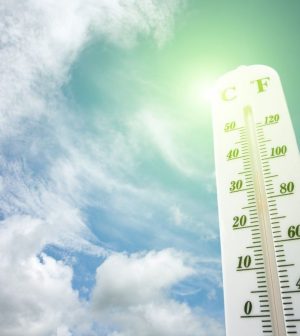- Navigating Your Midlife Crisis: Embracing New Possibilities
- City Raccoons Showing Signs of Domestication
- Mapping the Exposome: Science Broadens Focus to Environmental Disease Triggers
- One Week Less on Social Media Linked to Better Mental Health
- Your Brain Changes in Stages as You Age, Study Finds
- Some Suicide Victims Show No Typical Warning Signs, Study Finds
- ByHeart Formula Faces Lawsuits After Babies Sickened With Botulism
- Switch to Vegan Diet Could Cut Your Greenhouse Gas Emissions in Half
- Regular Bedtime Does Wonders for Blood Pressure
- Dining Alone Could Mean Worse Nutrition for Seniors
As Heat Waves Hit U.S., Poll Finds Most Can’t Locate Local Cooling Station

It’s been a sweltering summer for much of the United States, and a new poll finds many people can recognize the signs of heat sickness if it strikes them or someone else.
However, many more don’t know crucial information that could help them during a heatwave, such as the location of cooling centers where they can seek relief from the pounding heat, researchers discovered.
“Communities must do a better job of making the public, especially the most vulnerable, aware of these centers,” said Ken Winneg, managing director of survey research at the Annenberg Public Policy Center in Philadelphia.
NASA data shows that July 22 was the hottest day on record, and July might have been the hottest month, the pollsters noted.
Because of this, it’s important for people to know the signs of heat exhaustion and other heat-related illnesses.
Notably, most people know three of the telltale signs of heat illness, the poll found:
-
89% recognized dizziness as a symptom
-
83% knew nausea is a sign
-
72% knew hot, red, dry skin is cause for concern
However, only 42% knew of a fourth sign — skin that is pale, cold and clammy. In addition, only 3 in 10 knew that a pregnant woman exposed to extreme heat faces a heightened risk of premature delivery, the researchers noted.
Nearly all (92%) knew that drinking water is better at beating the heat than drinking sugary beverages.
The risks of heat exposure for older people were also better known, with two-thirds (67%) knowing that heat-related deaths are most common among seniors, researchers found.
Unfortunately, two-thirds of people in the poll (67%) said they don’t know where local cooling stations are located, despite rising temperatures.
The poll, published Aug. 9, also found that more people are starting to notice the effects of climate change.
For example, two-thirds (67%) said climate change is increasing the risk of heat illness, respiratory diseases and insect-borne diseases, compared to 58% in November 2023.
And two-thirds (65%) believe heat waves are becoming more frequent and intense, compared with 58% who felt that way in November 2023.
In addition, the percentage of people who say extreme heat has often or frequently affected their typical activities has increased significantly.
About 43% said extreme outdoor heat has cramped their summer style, an 8-point increase from November 2023.
People also expect things to get worse.
About 58% say they expect people in their community will be more likely to experience heat stroke caused by a heat wave during the next decade, up from 52% who thought so in November 2023.
The latest survey involved 1,496 U.S. adults polled July 11-18.
More information
The U.S. Centers for Disease Control and Prevention has more about symptoms of heat-related illness.
SOURCE: Annenberg Public Policy Center, news release, Aug. 9, 2024
Source: HealthDay
Copyright © 2025 HealthDay. All rights reserved.










